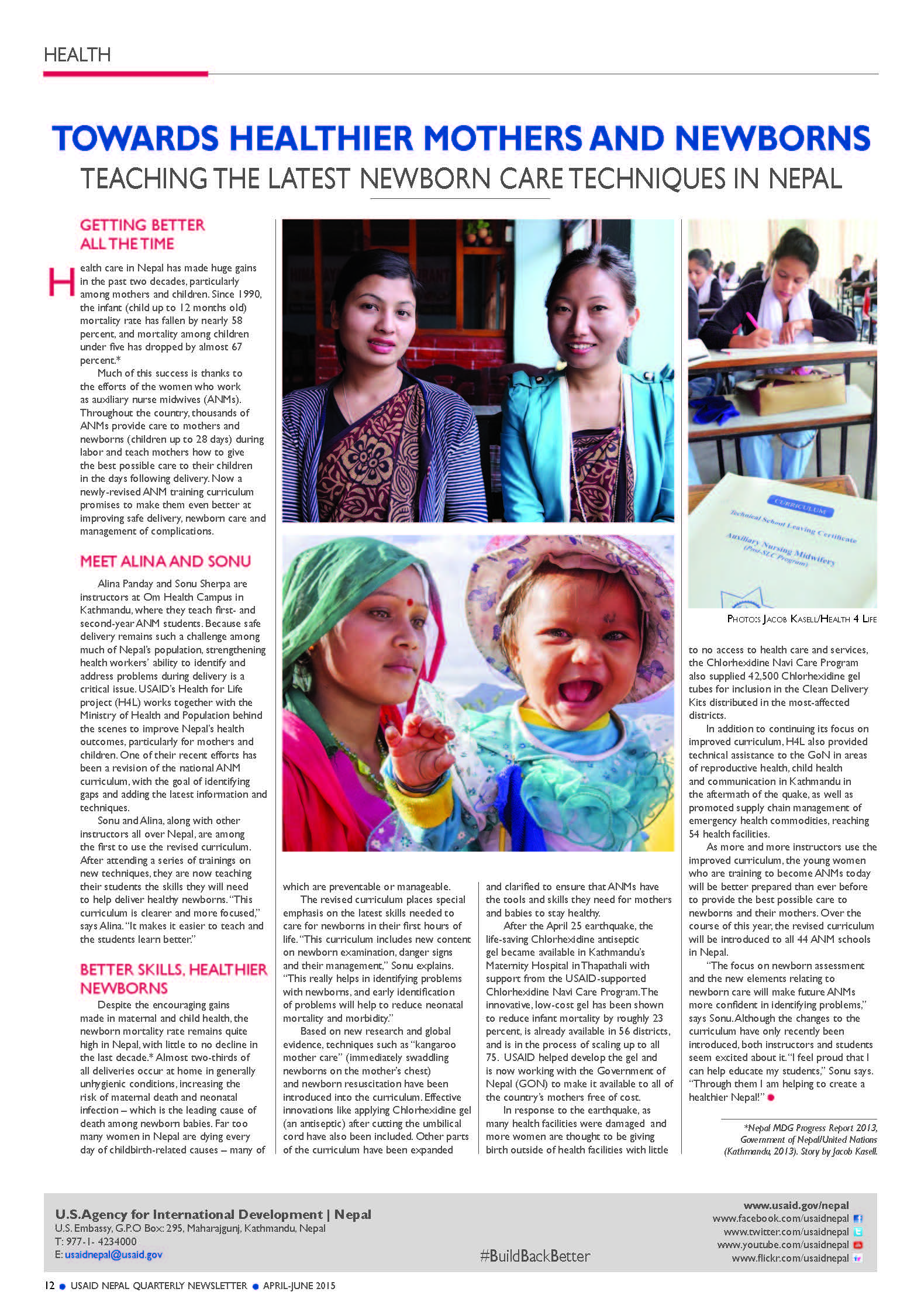Teaching the Latest Newborn Care Techniques in Nepal
Nepal Quarterly Newsletter, April-June 2015
GETTING BETTER ALL THE TIME
Health care in Nepal has made huge gains in the past two decades, particularly among mothers and children. Since 1990, the infant (child up to 12 months old) mortality rate has fallen by nearly 58 percent, and mortality among children under five has dropped by almost 67 percent.*
Much of this success is thanks to the efforts of the women who work as auxiliary nurse midwives (ANMs). Throughout the country, thousands of ANMs provide care to mothers and newborns (children up to 28 days) during labor and teach mothers how to give the best possible care to their children in the days following delivery. Now a newly-revised ANM training curriculum promises to make them even better at improving safe delivery, newborn care and management of complications.
MEET ALINA AND SONU
Alina Panday and Sonu Sherpa are instructors at Om Health Campus in Kathmandu, where they teach first- and second-year ANM students. Because safe delivery remains such a challenge among much of Nepal’s population, strengthening health workers’ ability to identify and address problems during delivery is a critical issue. USAID’s Health for Life project (H4L) works together with the Ministry of Health and Population behind the scenes to improve Nepal’s health outcomes, particularly for mothers and children. One of their recent efforts has been a revision of the national ANM curriculum, with the goal of identifying gaps and adding the latest information and techniques.
Sonu and Alina, along with other instructors all over Nepal, are among the first to use the revised curriculum. After attending a series of trainings on new techniques, they are now teaching their students the skills they will need to help deliver healthy newborns. “This curriculum is clearer and more focused,” says Alina. “It makes it easier to teach and the students learn better.”
BETTER SKILLS, HEALTHIER NEWBORNS
Despite the encouraging gains made in maternal and child health, the newborn mortality rate remains quite high in Nepal, with little to no decline in the last decade.* Almost two-thirds of all deliveries occur at home in generally unhygienic conditions, increasing the risk of maternal death and neonatal infection – which is the leading cause of death among newborn babies. Far too many women in Nepal are dying every day of childbirth-related causes – many of which are preventable or manageable.
The revised curriculum places special emphasis on the latest skills needed to care for newborns in their first hours of life. “This curriculum includes new content on newborn examination, danger signs and their management,” Sonu explains. “This really helps in identifying problems with newborns, and early identification of problems will help to reduce neonatal mortality and morbidity.”
Based on new research and global evidence, techniques such as “kangaroo mother care” (immediately swaddling newborns on the mother’s chest) and newborn resuscitation have been introduced into the curriculum. Effective innovations like applying Chlorhexidine gel (an antiseptic) after cutting the umbilical cord have also been included. Other parts of the curriculum have been expanded and clarified to ensure that ANMs have the tools and skills they need for mothers and babies to stay healthy.
After the April 25 earthquake, the life-saving Chlorhexidine antiseptic gel became available in Kathmandu’s Maternity Hospital in Thapathali with support from the USAID-supported Chlorhexidine Navi Care Program. The innovative, low-cost gel has been shown to reduce infant mortality by roughly 23 percent, is already available in 56 districts, and is in the process of scaling up to all 75. USAID helped develop the gel and is now working with the Government of Nepal (GON) to make it available to all of the country’s mothers free of cost.
In response to the earthquake, as many health facilities were damaged and more women are thought to be giving birth outside of health facilities with little to no access to health care and services, the Chlorhexidine Navi Care Program also supplied 42,500 Chlorhexidine gel tubes for inclusion in the Clean Delivery Kits distributed in the most-affected districts.
In addition to continuing its focus on improved curriculum, H4L also provided technical assistance to the GoN in areas of reproductive health, child health and communication in Kathmandu in the aftermath of the quake, as well as promoted supply chain management of emergency health commodities, reaching 54 health facilities.
As more and more instructors use the improved curriculum, the young women who are training to become ANMs today will be better prepared than ever before to provide the best possible care to newborns and their mothers. Over the course of this year, the revised curriculum will be introduced to all 44 ANM schools in Nepal.
“The focus on newborn assessment and the new elements relating to newborn care will make future ANMs more confident in identifying problems,” says Sonu. Although the changes to the curriculum have only recently been introduced, both instructors and students seem excited about it.“I feel proud that I can help educate my students,” Sonu says. “Through them I am helping to create a healthier Nepal!”
*Nepal MDG Progress Report 2013, Government of Nepal/United Nations (Kathmandu, 2013).
Story by Jacob Kasell.








Comment
Make a general inquiry or suggest an improvement.